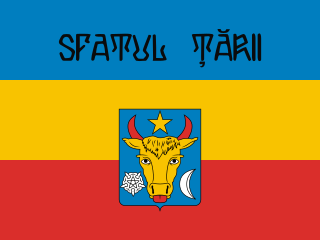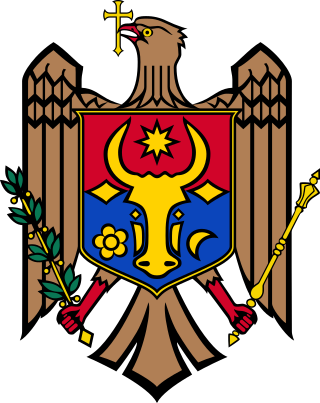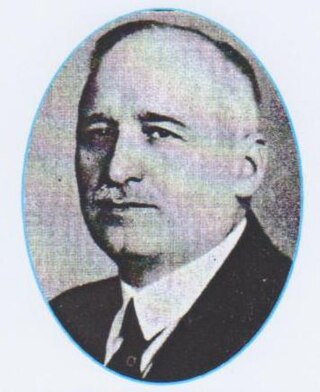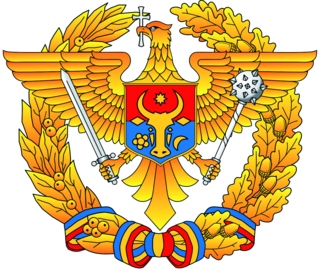The history of Moldova can be traced to the 1350s, when the Principality of Moldavia, the medieval precursor of modern Moldova and Romania, was founded. The principality was a vassal of the Ottoman Empire from 1538 until the 19th century. In 1812, following one of several Russian-Turkish wars, the eastern half of the principality, Bessarabia, was annexed by the Russian Empire. In 1918, Bessarabia briefly became independent as the Moldavian Democratic Republic and, following the decision of the Parliament, united with Romania. During the Second World War it was occupied by the Soviet Union which reclaimed it from Romania. It joined the Union as the Moldavian ASSR, until the dissolution of the USSR. In 1991 the country declared independence as the Republic of Moldova.

The Moldavian Democratic Republic, also known as the Moldavian Republic, was a state proclaimed on 15 December [O.S. 2 December] 1917 by the Sfatul Țării of Bessarabia, elected in October–November 1917 following the February Revolution and the start of the disintegration of the Russian Empire.

The Prime Minister of Moldova is Moldova's head of government. The prime minister is formally appointed by the president of Moldova and exercises executive power along with the cabinet, subject to parliamentary support. Dorin Recean has been serving as prime minister since 16 February 2023 following the dissolution of the Gavrilița cabinet.

Sfatul Țării was a council that united political, public, cultural, and professional organizations in the greater part of the territory of the Governorate of Bessarabia in the disintegrating Russian Empire, which was transformed into a Legislative body and proclaimed the Moldavian Democratic Republic as part of the Russian Federative Republic in December 1917, and then union with Romania in April [O.S. March] 1918.

The Bessarabian Peasants' Party or Moldavian National Democratic Party was an agrarian political party, active in the Kingdom of Romania and, more specifically, the region of Bessarabia. Comprising various pro-Romanian and regionalist factions that had existed within the Moldavian Democratic Republic, it was brought together by shared opposition to Bolshevik Russia and communism. The PȚB, founded in August 1918, was led by Pan Halippa and Ion Inculeț, originally representing, respectively, its right and left wings; Ion Pelivan was the co-chair.

Ion Constantin Inculeț was a Bessarabian and Romanian politician, the President of the Country Council of the Moldavian Democratic Republic, Minister, full member of the Romanian Academy. He was buried in the Church of St. Ioan Botezătorul of Bârnova, located on the outskirts of Iași. He was married to Princess Roxana Cantacuzino. His children from this marriage were Ion I. Inculeț, Doctor Honoris Causa of the University of Western Ontario (Canada), NASA consultant, Honorary Member of the Romanian Academy, director of the Center of Applied Electrostatics of the University of Western Ontario, and his brother, George I. Inculeț.

Pantelimon Erhan was a Bessarabian politician and prime minister of the Moldavian Democratic Republic (1917–1918).

Daniel Ciugureanu Cabinet was the Cabinet of Moldova.

Indirect elections for the Moldovan Parliament took place in Moldova in November 1917. The members were elected by the various congresses, soviets, parties and professional and ethnic organizations existing in Bessarabia in the wake of the Russian Revolution.

Gherman Vasile Pântea was a Bessarabian-born soldier, civil servant and political figure, active in the Russian Empire and Romania. As an officer of the Imperial Russian Army during most of World War I, he helped organize the committees of Bessarabian soldiers, oscillating between loyalty to the Russian Provisional Government and the cause of Bessarabian emancipation. Pântea was subsequently Military Director of the Moldavian Democratic Republic, answering to President Ion Inculeț. He personally created a Bessarabian defense force, tasked with combating Bolshevik subversion and Russian intimidation, but also braced for defeat after the October Revolution.

Ion T. Costin was a Moldovan politician.
Nicolae Bosie-Codreanu was a Bessarabian politician who voted for the Union of Bessarabia with Romania on 27 March 1918.

Vasile Cijevschi was a Bessarabian and Romanian politician, administrator and writer. Originally a career officer in the Russian Empire, he was active within the ethnic Romanian political movement during the Russian Revolution, and later within the Moldavian Democratic Republic. Cijevschi helped organize the Republic's defense against bolshevik insurrection, and contributed to the Bessarabian–Romanian union of 1918.

Ion Alion Buzdugan was a Bessarabian-Romanian poet, folklorist, and politician. A young schoolteacher in the Russian Empire by 1908, he wrote poetry and collected folklore emphasizing Bessarabia's links with Romania, and associated with various founding figures of the Romanian nationalist movement, beginning with Ion Pelivan. Buzdugan was a far-left figure during the February Revolution, but eventually rallied with the National Moldavian Party in opposition to the socialists and the Bolsheviks. He vehemently supported the union of Bessarabia with Romania during the existence of an independent Moldavian Democratic Republic, and, as a member of its legislature, worked to bring it about. Threatened by the Bolsheviks, he fled to Romania and returned with an expeditionary corps headed by General Ernest Broșteanu, being one of the delegates who voted for the union, and one of dignitaries who signed its proclamation.

The Ministry of Defence of Moldova is one of the fourteen ministries of the Government of Moldova. It is the main executive body responsible for the managing of the Armed Forces of Moldova.

Chișinău has a recorded history that goes back to 1436. Since then, it has grown to become a significant political and cultural capital of South East Europe. In 1918 Chișinău became the capital of an independent state, the Moldavian Democratic Republic, and has been the capital of Moldova since 1991.
Mihail Savenco was a Moldovan politician of Ukrainian descent. He was a high-ranking official of the Moldavian Democratic Republic.
Vladimir Vladimirovich Tsyganko was a Bessarabian, and later Soviet, politician. The son of a distinguished architect, and himself an engineer by vocation, Tsyganko entered politics shortly before the proclamation of a Moldavian Democratic Republic, when he earned a seat in the republican legislature. He sided with the parliamentary Peasants' Faction, which supported left-wing ideals and pushed for land reform, being generally, and radically, opposed to the more right-wing Moldavian Bloc. Tsyganko was skeptical of the Bloc's plan to unite Bessarabia with Romania, although he possibly supported a federation. His uncompromising stance divided his Faction and led the Romanian Kingdom's authorities to identify him as a major obstruction to the unionist cause.

Anatolie Popa was a Bessarabian-born military commander active during World War I and the Russian Revolution and Civil War, one of the organisers of the Moldavian armed resistance against the advancing Romanian troops in January 1918.

The Romanian military intervention in Bessarabia took place between 19 January and 8 March 1918, as part of the broader Allied intervention in the Russian Civil War. It pitted the Kingdom of Romania, Russian Republic, Ukrainian People's Republic and anti-Bolshevik factions of the Moldavian Democratic Republic on one side, against the Bolshevik controlled Rumcherod and Odessa Soviet Republic, as well as pro-Bolshevik factions within the Moldavian DR. The intervention began when the Romanian army and its allies crossed into Bessarabia and launched an attack on Chișinău and Ungheni, capturing the latter.















